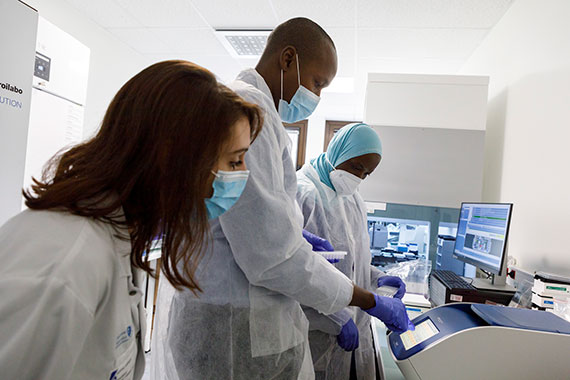Laboratory equipment and reagents
Provision of equipment to build partner-laboratory sequencing and PCR screening capacities.

14
Number of sequencing platforms operational
10957
Number of sequences produced between July 2021 and August 2024
Project objectives
The main objective of the project is for each country to have sequencing capabilities and routine variant surveillance activities.
During the period in which this equipment and these techniques are made available, the laboratories are supported in the implementation of a screening PCR that allows the detection of multiple SARS-CoV-2 mutations, including those specific to the Omicron variant, and which will subsequently help in the pre-selection of samples to be sequenced as a priority.
The AFROSCREEN project also allows for the implementation of an external evaluation of the quality of the sequencing (and/or screening) results obtained by the different laboratories.
The project adapts the actions to the partner structures in order to generate a sustainable sequencing capacity in the countries, which will be used in the future for the identification of emerging pathogens.
Technological advances
Technological advances enabling real-time genome sequencing have had a considerable impact on public health and the response to the Covid-19 pandemic.
Indeed, the sharing of viral genome sequences has enabled the rapid identification of the new pathogen, SARS-CoV-2, and the development of diagnostic tests and vaccines. In countries where the technology is available, large-scale genome sequencing now makes it possible to monitor the evolution of the virus, identify chains of transmission, design countermeasures, and even create new diagnostic tests and vaccines adapted to the variants. Nevertheless, this technology is not uniformly available worldwide, and in particular sequencing and virological surveillance are still limited in Africa.
The emergence in November 2022 of the SARS-CoV-2 virus of the Omicron variant has served as a reminder that sequencing capabilities are needed at the national level to alert the world to a potential threat.
It is therefore essential to create or strengthen sequencing capabilities and the genomic surveillance system in each country.
AFROSCREEN network laboratories
At the start of the project in 2021, the laboratories in the AFROSCREEN network had a range of skills and capacities.
Some had no capacity to detect genomic variants before the start of the project, while others were already regional reference centers identified by the authoritative bodies (WHO, Africa CDC and WAHO).
The AFROSCREEN project took into consideration the specific needs of each laboratory and, depending on the existing situation, its missions and the needs identified, strengthened it through the purchase of more suitable equipment and the necessary reagents, and the training of teams.
By 2025, the laboratories in the AFROSCREEN network will have enhanced capacities for genomic surveillance thanks to adapted equipment, including sequencing platforms and essential auxiliary tools. Some have become autonomous regional centers for the detection and characterization of emerging pathogens.
Initially focused on SARS-CoV-2, since 2022 AFROSCREEN has been supporting the surveillance of pathogens with epidemic potential such as mpox, dengue and influenza viruses, integrating the principles of One Health for an interdisciplinary approach aimed at understanding human, animal and environmental health.
There are now two methods for detecting variants:
- PCR screening, which detects variants of interest carrying known mutations and provides results in a short time (about two hours after extraction) and at an affordable price.
- Whole genome sequencing, which identifies known or unknown variants and allows for phylogeny studies (identifying epidemiological links between variants).
- This method is longer (about three days) and more expensive.
